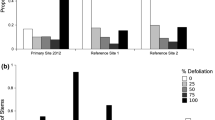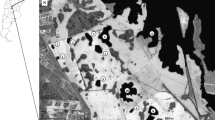Abstract
The introduction of the hemlock woolly adelgid (Adelges tsugae) in the eastern United States has caused extensive damage to eastern hemlock (Tsuga canadensis) stands. The presence of other herbivores can affect adelgid density and hemlock health. Here, we report the results of long-term work monitoring hemlock forests in a 7,500 km2 latitudinal transect of southern New England. In biannual surveys between 1997 and 2011, we assessed change in hemlock basal area, stand-level hemlock defoliation, the density of four exotic herbivores (A. tsugae, Fiorinia externa, Nuculaspis tsugae and an unidentified Nuculaspis sp.) and explored relationships between biotic and abiotic variables. Hemlock basal area decreased by approximately 60 % over the 14 years of the study. Hemlock stand defoliation increased locally in some stands but on average stand defoliation did not change throughout the study period/area. Local increases in defoliation were probably driven by the northward expansion by A. tsugae, and to a certain extent by the co-occurring presence of F. externa and Nuculaspis scales. Average F. externa density increased during the study and also expanded dramatically northward, although its density did not impact hemlock stand defoliation and only reduced hemlock basal area in some stands. Stand-level variation in F. externa densities was most strongly affected by the presence of Nuculaspis scales, which were present in about 80 % of the stands. While A. tsugae continues to be the primary threat to eastern hemlock, its impact needs to be studied in the context of a broader herbivore community.






Similar content being viewed by others
References
Ando Y, Utsumi S, Ohgushi T (2011) Community-wide impact of an exotic aphid on introduced tall goldenrod. Ecol Entomol 36:643–653
Breiman L, Olshen JH, Stone CJ (1984) Classification and regression trees. Chapman and Hall, New York
De’ath G, Fabricius KE (2000) Classification and regression trees: a powerful yet simple technique for ecological data analysis. Ecology 81:3178–3192
Dukes JS, Pontius J, Orwig D, Garnas JR, Rodgers VL, Brazee N, Cooke B, Theoharides KA, Stange EE, Harrington R, Ehrenfeld J, Gurevitch J, Lerdau M, Stinson K, Wick R, Ayres M (2009) Responses of insect pests, pathogens, and invasive plant species to climate change in the forests of northeastern North America: what can we predict? Can J For Res Revue Canadienne De Recherche Forestiere 39:231–248
Evans AM, Gregoire TG (2007) A geographically variable model of hemlock woolly adelgid spread. Biol Invasions 9:369–382
Fitzpatrick MC, Preisser EL, Porter A, Elkinton J, Waller LA, Carlin BP, Ellison AM (2010) Ecological boundary detection using Bayesian areal wombling. Ecology 91:3448–3455
Fitzpatrick MC, Preisser EL, Porter A, Elkinton J, Ellison AM (2012) Modeling range dynamics in heterogeneous landscapes: invasion of the hemlock woolly adelgid in eastern North America. Ecol Appl 22:472–486
Ford CR, Elliott KJ, Clinton BD, Kloeppel BD, Vose JM (2012) Forest dynamics following eastern hemlock mortality in the southern Appalachians. Oikos 121:523–536
Gandhi KJK, Herms DA (2010) Direct and indirect effects of alien insect herbivores on ecological processes and interactions in forests of eastern North America. Biol Invasions 12:389–405
Gómez S, Orians CM, Preisser EL (2012) Exotic herbivores on a shared native host: tissue quality after individual, simultaneous, and sequential attack. Oecologia 169:1015–1024
Gómez S, Gonda-King L, Orians CM, Preisser EL (2014) Competitor avoidance drives within-host feeding site selection in a passively-dispersed herbivore. Ecol Entomol (in press). doi:10.1111/een.12059
Grosenbaughl LR (1952) Plotless timber estimates—new, fast, easy. J For 50:32–37
Havill NP, Montgomery ME, Yu GY, Shiyake S, Caccone A (2006) Mitochondrial DNA from hemlock woolly adelgid (Hemiptera: Adelgidae) suggests cryptic speciation and pinpoints the source of the introduction to eastern North America. Ann Entomol Soc Am 99:195–203
Hollingsworth RG, Hain FP (1991) Balsam woolly adelgid (Homoptera, Adelgidae) and spruce-fir decline in the southern Appalachians—assessing pest relevance in a damaged ecosystem. Fla Entomol 74:179–187
Holmes TP, Murphy EA, Bell KP, Royle DD (2010) Property value impacts of hemlock woolly adelgid in residential forests. For Sci 56:529–540
Hurvich CM, Tsai CL (1989) Regression and time-series model selection in small samples. Biometrika 76:297–307
Johnson JB, Omland KS (2004) Model selection in ecology and evolution. Trends Ecol Evol 19:101–108
Krapfl KJ, Holzmueller EJ, Jenkins MA (2011) Early impacts of hemlock woolly adelgid in Tsuga canadensis forest communities of the southern Appalachian mountains. J Torrey Bot Soc 138:93–106
Lewis JD, Licitra J, Tuininga AR, Sirulnik A, Turner GD, Johnson J (2008) Oak seedling growth and ectomycorrhizal colonization are less in eastern hemlock stands infested with hemlock woolly adelgid than in adjacent oak stands. Tree Physiol 28:629–636
Liebhold AM, Tobin PC (2008) Population ecology of insect invasions and their management. Annu Rev Entomol 53:387–408
Liebhold AM, Macdonald WL, Bergdahl D, Maestro VC (1995) Invasion by exotic forest pests—a threat to forest ecosystems. For Sci 41:1–49
Mathewson B (2009) The relative abundance of eastern red-backed salamanders in eastern hemlock-dominated and mixed deciduous forests at Harvard forest. Northeast Nat 16:1–12
McClure MS (1980) Foliar nitrogen—a basis for host suitability for elongate hemlock scale, Fiorinia externa (Homoptera, Diaspididae). Ecology 61:72–79
McClure MS (1981) Effects of voltinism, interspecific competition and parasitism on the population dynamics of the hemlock scales, Fiorinia externa and Tsugaspidiotus tsugae (Homoptera, Diaspididae). Ecol Entomol 6:47–54
McClure MS (1989a) Evidence of a polymorphic life-cycle in the hemlock woolly adelgid, Adelges tsugae (Homoptera, Adelgidae). Ann Entomol Soc Am 82:50–54
McClure MS (1989b) Importance of weather to the distribution and abundance of introduced adelgid and scale insects. Agric For Meteorol 47:291–302
McClure MS, Fergione MB (1977) Fiorinia externa and Tsugaspidiotus tsugae (Homoptera-Diaspididae)—distribution, abundance, and new hosts of 2 destructive scale insects of eastern hemlock in Connecticut. Environ Entomol 6:807–811
Miller-Pierce MR, Preisser EL (2012) Asymmetric priority effects influence the success of invasive forest insects. Ecol Entomol 37:350–358
Niemela P, Mattson WJ (1996) Invasion of North American forests by European phytophagous insects—legacy of the European crucible? Bioscience 46:741–753
Orwig DA, Foster DR, Mausel DL (2002) Landscape patterns of hemlock decline in New England due to the introduced hemlock woolly adelgid. J Biogeogr 29:1475–1487
Orwig DA, Thompson JR, Povak NA, Manner M, Niebyl D, Foster DR (2012) A foundation tree at the precipice: Tsuga canadensis health after the arrival of Adelges tsugae in central New England. Ecosphere 3(1):1–16
Paradis AF (2011) Population dynamics of the hemlock woolly adelgid (Hemiptera: Adelgidae). Dissertation, University of Massachusetts Amherst
Poland TM, McCullough DG (2006) Emerald ash borer: invasion of the urban forest and the threat to North America’s ash resource. J For 104:118–124
Preisser EL, Elkinton JS (2008) Exploitative competition between invasive herbivores benefits a native host plant. Ecology 89:2671–2677
Preisser EL, Lodge AG, Orwig DA, Elkinton JS (2008) Range expansion and population dynamics of co-occurring invasive herbivores. Biol Invasions 10:201–213
Preisser EL, Miller-Pierce MR, Vansant J, Orwig DA (2011) Eastern hemlock (Tsuga canadensis) regeneration in the presence of hemlock woolly adelgid (Adelges tsugae) and elongate hemlock scale (Fiorinia externa). Can J For Res Revue Canadienne De Recherche Forestiere 41:2433–2439
Rohr JR, Mahan CG, Kim KC (2009) Response of arthropod biodiversity to foundation species declines: the case of the eastern hemlock. For Ecol Manage 258:1503–1510
Ross RM, Redell LA, Bennett RM, Young JA (2004) Mesohabitat use of threatened hemlock forests by breeding birds of the Delaware river basin in northeastern United States. Nat Areas J 24:307–315
Siderhurst LA, Griscom HP, Hudy M, Bortolot ZJ (2010) Changes in light levels and stream temperatures with loss of eastern hemlock (Tsuga canadensis) at a southern Appalachian stream: Implications for brook trout. For Ecol Manage 260:1677–1688
Skinner M, Parker BL, Gouli S, Ashikaga T (2003) Regional responses of hemlock woolly adelgid (Homoptera: Adelgidae) to low temperatures. Environ Entomol 32:523–528
Souto D, Luther T, Chianese B (1996) Past and current status of HWA in eastern and Carolina hemlock stands. In: Salom SM, Tigner TC, Reardon RC (eds) Proceedings of the first hemlock woolly adelgid review. USDA Forest Service, Morgantown, pp 9–15
Spaulding HL, Rieske LK (2010) The aftermath of an invasion: Structure and composition of central Appalachian hemlock forests following establishment of the hemlock woolly adelgid, Adelges tsugae. Biol Invasions 12:3135–3143
Tingley MW, Orwig DA, Field R, Motzkin G (2002) Avian response to removal of a forest dominant: consequences of hemlock woolly adelgid infestations. J Biogeogr 29:1505–1516
Trotter III RT, Evans AM (2010) Native communities on an exotic tree: the arthropod community on Tsuga chinensis in New England; a potential ecological surrogate for T. canadensis. Fifth symposium on Hemlock Woolly Adelgid in the Eastern United States, pp 132–138
Trotter RT III, Morin RS, Oswalt SN, Liebhold A (2013) Changes in the regional abundance of hemlock associated with the invasion of hemlock woolly adelgid (Adelges tsugae Annand). Biol Invasions 15:2667–2679
Utsumi S, Ando Y, Roininen H, Takahashi J, Ohgushi T (2013) Herbivore community promotes trait evolution in a leaf beetle via induced plant response. Ecol Lett 16:362–370
Weed AS, Ayres MP, Hicke JA (2013) Consequences of climate change for biotic disturbances in North American forests. Ecol Monogr 83:441–470
Acknowledgments
The authors thank property owners for allowing survey teams in their plots. B. Peixoto for her help during fieldwork and P. August for the landscape figures in the manuscript. This project was funded by the following grants: NSF DEB-0715504, NSF DEB-1256769, NIFA 2011-67013-30142 and is a contribution of the Harvard Forest Long-Term Ecological Research Program (DEB 06-20443).
Author information
Authors and Affiliations
Corresponding author
Rights and permissions
About this article
Cite this article
Gómez, S., Gonda-King, L., Orians, C.M. et al. Interactions between invasive herbivores and their long-term impact on New England hemlock forests. Biol Invasions 17, 661–673 (2015). https://doi.org/10.1007/s10530-014-0757-3
Received:
Accepted:
Published:
Issue Date:
DOI: https://doi.org/10.1007/s10530-014-0757-3




